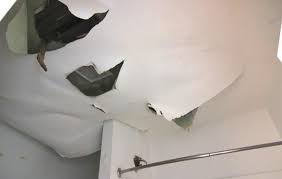The Facts, Ma’am, Just the Facts
The Pasleys purchased a homeowners insurance policy from State Farm. Mold is not usually covered in homeowners insurance policies. However, the Pasleys bought a mold endorsement. The coverage limit was $5,000 “for all loss by fungus’…including ‘the cost of any testing or monitoring of…property to confirm the type, absence, presence or level of fungus.”
During a storm their roof drain failed causing water to leak through the ceiling and enter the master bedroom.
State Farm paid for much of the repair work, but would not pay for replacing the ceiling in the master bathroom. The Pasley’s position was that the master bath ceiling likely sustained water damage, even if such damage could not be observed without removing the ceiling. State Farm’s position was that removal of the ceiling amounted to testing or monitoring to confirm the presence of fungus. The Pasley’s contractor removed the ceiling and asked State Farm to re-inspection the debris. By the time State Farm’s inspector could visit the property (two days after the request was made) the debris had been disposed of.
A Brief Lesson in Jurisprudence
The trial court tossed the case out of court on grounds that there were no “triable issues of material fact.” A trial court’s decision to summarily reject a suit may be reviewed by an appellate court. But, review is limited to whether a reasonable jury could find that the facts, as stated by one party, differ from the facts stated by the other party. The appellate court does not decide which of the two parties are correct, but, merely whether reasonable jurors could find for the party whose case was thrown out. When the appellate court disagrees with the trial court the case is returned to the lower court for trial.
The Court’s Decision
State Farm argued that work done in the master bath to discover water damage should be limited to the $5,000 cap on expenses under the mold endorsement. The court did not agree and made this statement:
“Although the coverage limitation applies to the costs of the initial testing to confirm the “absence” or “presence” of mold, it does not encompass the additional costs of repairing the water damage that [the Pasleys] claim to have found in the master bathroom, as that damage is not reasonably viewed as a “loss by fungus.“
Our Two-Cents
The court’s analysis of the mold endorsement limitation makes sense. The point of addressing water damage is to prevent the development of mold later on. When the work to the master bath was done there was only water damage. But, left untreated, the problem would have changed from one of water damage to one of fungal infestation.
To be fair, State Farm paid out over $250,000 in insurance benefits to the Pasley’s, including rental housing at $9,000 per month for 6 months while the work was being done. However, if the Pasley’s had not done the exploratory work to discover whether water was present in the drywall in the master bathroom, mold, almost certainly. would develop and along with it very real and serious risks to their health.
There is no mention in the published case about the role the Pasley’s insurance agent may have played. But, as independent insurance agents, we know that a thorough understanding of the insurance contract provisions and how courts interpret the language can make a tremendous difference in the level of service and benefits paid when a policy holder makes a claim.

